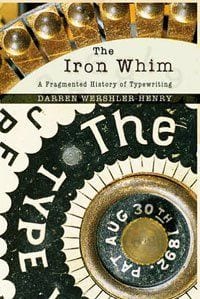
… men whose natural and sole habitat was the college town: failed or failing graduate students, drunk professors or book editors like my father, all of them wearing corduroy jackets in various stages of disrepair. These guys had once had their fields — Victorian literature, tropical botany, the cultural import of the manual typewriter — but one day they discovered they didn’t like their fields anymore, not as much as they liked to drink.
— Brock Clarke, An Arsonist’s Guide to Writers’ Homes in New England
Sam Pulsifer’s ruminations on his father’s editing career at a university press clinch one point: Sam’s no reader. For who could fail to see to the typewriter’s appeal? Everyone remembers Dracula‘s Mina Harker, typing away on early versions of carbon paper, and isn’t the most famous booty call in high modernist poetry the assignation between The Waste Land‘s young man carbuncular and the typist? Here in my room I can look up and see Tom Gallon’s The Girl Behind the Keys, about a typewriter girl with a penchant for crime-solving, and H. G. Wells’s Tono-Bungay, where two characters on the verge of an infidelity admire a new typewriter as if it were an iPhone.
Darren Wershler-Henry’s The Iron Whim is less a history of typewriting than a history of its image. The book opens by recollecting the peculiar 20th-century involution whereby “once, typewriting symbolized all that was antithetical to poetry; it was cold, mechanical, awkward. Now, however, through the misty lens of nostalgia created by several centuries of typewriting’s own propaganda, we believe that typewriting is poetry: precise, clean, elegant in its minimalism.” Wershler-Henry is a surefooted guide to some of the stranger claims made on typewriting’s behalf.
Wershler-Henry has written several books, both nonfiction and poetry, about the mutually constitutive and confounding intersections of technology and culture. With Bill Kennedy, he is the author of apostrophe, a book of poems composed by a search engine they designed. (I reviewed apostrophe in PopMatters a year ago). The Iron Whim reflects that deep engagement, as it is a book equally at home with avant-garde poetry and with, say, the biometrical fantasies of Frank Gilbreth’s “scientific management.” The book speaks to aspects of typewriting both controversial (QWERTY vs. Dvorak layouts) and silly (just what will those monkeys type on those infinite typewriters?).
The Iron Whim‘s thesis is that the iconography of typewriting is almost preternaturally self-deconstructing. Typewriting produces the truth, but is easily forged. Typewriting, Wershler-Henry suggests, makes visible, albeit sometimes only as a ghost, an Other voice in the scene of writing. Sometimes this Other is a speaker dictating with authority; other times it is the typist, revising that dictation on the fly. Still other times the typewriter itself is the Other, as it seems to transmogrify from instrument to muse to tyrannical master in the writerly imagination.
Calling this argument a “thesis” probably goes too far, as The Iron Whim is deliberately fragmentary and elliptical. This decision is, we’re told, located deep within the logic of typewriting itself:
A whim (a capricious notion or fancy) could inspire a person to press a few keys on their whim (a typewriter as a fanciful or fantastic object), and the inspiration would be conveyed to paper by … a whim (a machine consisting of a central drum mechanism with a number of linked radial arms). Writing about the machine itself would be the most whimsical act of all, but it would give substance to the initial whimsies about that machine, as if those whims had been cast in iron.
There are some drawbacks to this “fragmentary” history, most of which arise from its wide-ranging approach. Disciplinary experts in Victorian and modernist literature, for example, will probably be startled to hear that “typewriting in Dracula … has been overlooked.” That’s only true if “overlooked” means “understood as highly relevant for quite some time now. He’s in a related tight spot when it comes to theory. While he offers lucid, accessible statements of key arguments by Foucault, Derrida, Kittler, Virilio, and others, his formulations are occasionally (and perhaps necessarily) under-nuanced. The associative leaps are sometimes less persuasive than a more conventional timeline would be — oddly, we discover how William S. Burroughs destroys typewriting’s disciplinary powers before we discover what those powers are.
Wershler-Henry eschews any claim to comprehensiveness; however, there are a couple of related phenomena that I found myself wishing he had addressed. The first is “erasable” typewriters. Surely the ostensible permanence of the typewritten mark connects up with claims that the typewriter produces the truth. A second example that’s close to any academic’s heart is the phenomenon that Kieran Healy has called “the typing wife” of academics’ first books. I’m sensitive to both these topics, since, family legend has it, my mother was locked away furiously typing my father’s dissertation while I was an infant. In the days before word processing, a mistake on a page’s 20th line had material — and, to be sure, marital! — consequences.
But these are small blemishes on a book rich with telling anecdotes, conceptual ambition, and an easy, charming style. I have been reminded about this book in a variety of contexts. Apple’s decision to have the iPhone’s virtual keyboard make audible clicks evokes typists’ objection to noiseless typewriters. Since he devotes a whole chapter to the modern children’s classic, Click, Clack, Moo, one wonders what Wershler-Henry thinks of the prominent role a pencil plays in Giggle, Giggle, Quack, and so on. Anyone interested in technology and writing — in the technology that writing is and is conditioned by — will enjoy The Iron Whim.

![Call for Papers: All Things Reconsidered [MUSIC] May-August 2024](https://www.popmatters.com/wp-content/uploads/2024/04/all-things-reconsidered-call-music-may-2024-720x380.jpg)



